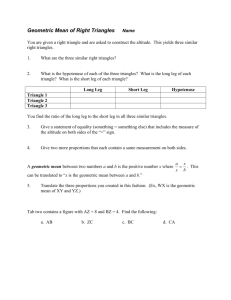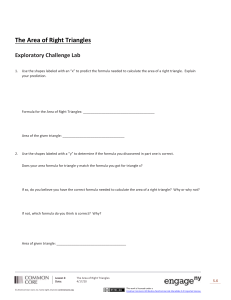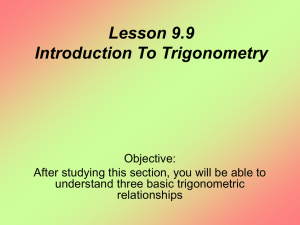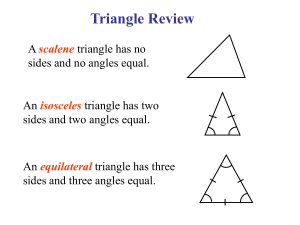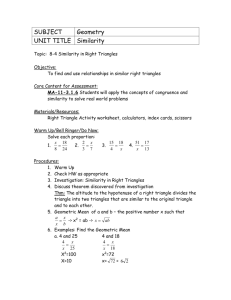Right Triangles: Similar Sub-Triangles Lesson
advertisement
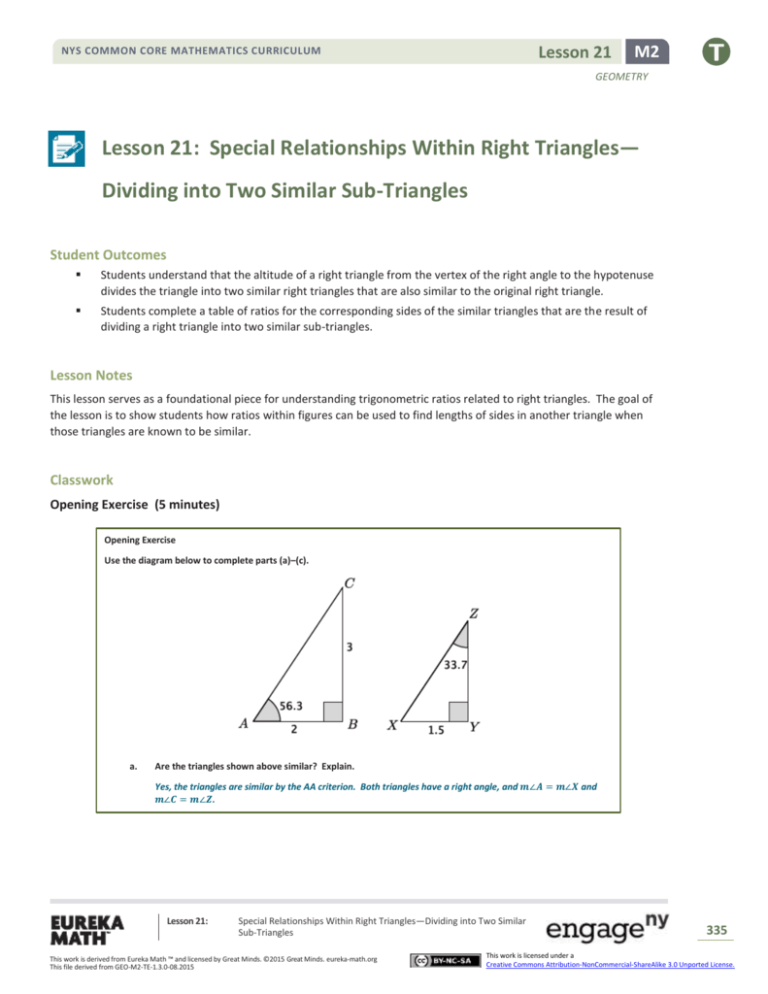
Lesson 21 NYS COMMON CORE MATHEMATICS CURRICULUM M2 GEOMETRY Lesson 21: Special Relationships Within Right Triangles— h Dividing into Two Similar Sub-Triangles Student Outcomes Students understand that the altitude of a right triangle from the vertex of the right angle to the hypotenuse divides the triangle into two similar right triangles that are also similar to the original right triangle. Students complete a table of ratios for the corresponding sides of the similar triangles that are the result of dividing a right triangle into two similar sub-triangles. Lesson Notes This lesson serves as a foundational piece for understanding trigonometric ratios related to right triangles. The goal of the lesson is to show students how ratios within figures can be used to find lengths of sides in another triangle when those triangles are known to be similar. Classwork Opening Exercise (5 minutes) Opening Exercise Use the diagram below to complete parts (a)–(c). a. Are the triangles shown above similar? Explain. Yes, the triangles are similar by the AA criterion. Both triangles have a right angle, and 𝒎∠𝑨 = 𝒎∠𝑿 and 𝒎∠𝑪 = 𝒎∠𝒁. Lesson 21: Special Relationships Within Right Triangles—Dividing into Two Similar Sub-Triangles This work is derived from Eureka Math ™ and licensed by Great Minds. ©2015 Great Minds. eureka-math.org This file derived from GEO-M2-TE-1.3.0-08.2015 335 This work is licensed under a Creative Commons Attribution-NonCommercial-ShareAlike 3.0 Unported License. Lesson 21 NYS COMMON CORE MATHEMATICS CURRICULUM M2 GEOMETRY b. Determine the unknown lengths of the triangles. ̅̅̅̅. Let 𝒙 represent the length of 𝒀𝒁 𝟑 𝒙 = 𝟐 𝟏. 𝟓 𝟐𝒙 = 𝟒. 𝟓 𝒙 = 𝟐. 𝟐𝟓 Let 𝒚 be the length of the hypotenuse of △ 𝑨𝑩𝑪. 𝟐𝟐 + 𝟑𝟐 = 𝒚𝟐 𝟒 + 𝟗 = 𝒚𝟐 𝟏𝟑 = 𝒚𝟐 √𝟏𝟑 = 𝒚 Let 𝒛 be the length of the hypotenuse of △ 𝑿𝒀𝒁. 𝟏. 𝟓𝟐 + 𝟐. 𝟐𝟓𝟐 = 𝒛𝟐 𝟐. 𝟐𝟓 + 𝟓. 𝟎𝟔𝟐𝟓 = 𝒛𝟐 𝟕. 𝟑𝟏𝟐𝟓 = 𝒛𝟐 √𝟕. 𝟑𝟏𝟐𝟓 = 𝒛 c. Explain how you found the lengths in part (a). Since the triangles are similar, I used the values of the ratios of the corresponding side lengths to determine ̅̅̅̅ and 𝑿𝒁 ̅̅̅̅. To determine the lengths of 𝑨𝑪 ̅̅̅̅, I used the Pythagorean theorem. the length of 𝒀𝒁 Example 1 (15 minutes) In Example 1, students learn that when a perpendicular is drawn from the right angle to the hypotenuse of a right triangle, the triangle is divided into two sub-triangles. Further, students show that all three of the triangles, the original one and the two formed by the perpendicular, are similar. Example 1 Recall that an altitude of a triangle is a perpendicular line segment from a vertex to the line ̅̅̅̅̅ is the altitude from vertex 𝑩 to the line determined by the opposite side. In △ 𝑨𝑩𝑪 below, 𝑩𝑫 containing ̅̅̅̅ 𝑨𝑪. a. How many triangles do you see in the figure? There are three triangles in the figure. b. Identify the three triangles by name. Note that there are many ways to name the three triangles. Ensure that the names students give show corresponding angles. Scaffolding: A good hands-on visual that can be used here requires a 3 × 5 notecard. Have students draw the diagonal and then draw the perpendicular line from 𝐵 to side 𝐴𝐶. Make sure students label all of the parts to match the triangles before they make the cuts. Next, have students cut out the three triangles. Students then have a notecard version of the three triangles shown and are better able to see the relationships among them. △ 𝑨𝑩𝑪, △ 𝑨𝑫𝑩, and △ 𝑩𝑫𝑪. Lesson 21: Special Relationships Within Right Triangles—Dividing into Two Similar Sub-Triangles This work is derived from Eureka Math ™ and licensed by Great Minds. ©2015 Great Minds. eureka-math.org This file derived from GEO-M2-TE-1.3.0-08.2015 336 This work is licensed under a Creative Commons Attribution-NonCommercial-ShareAlike 3.0 Unported License. Lesson 21 NYS COMMON CORE MATHEMATICS CURRICULUM M2 GEOMETRY We want to consider the altitude of a right triangle from the right angle to the hypotenuse. The altitude of a right triangle splits the triangle into two right triangles, each of which shares a common acute angle with the original triangle. In △ 𝑨𝑩𝑪, the altitude ̅̅̅̅̅ 𝑩𝑫 divides the right triangle into two sub-triangles, △ 𝑩𝑫𝑪 and △ 𝑨𝑫𝑩. c. Is △ 𝑨𝑩𝑪 ~ △ 𝑩𝑫𝑪? Is △ 𝑨𝑩𝑪 ~ △ 𝑨𝑫𝑩? Explain. △ 𝑨𝑩𝑪 and △ 𝑩𝑫𝑪 are similar by the AA criterion. Each has a right angle, and each shares ∠𝑪. △ 𝑨𝑩𝑪 and △ 𝑨𝑫𝑩 are similar because each has a right angle, and each shares ∠𝑨, so, again, these triangles are similar by the AA criterion. d. Is △ 𝑨𝑩𝑪 ~ △ 𝑫𝑩𝑪? Explain. △ 𝑨𝑩𝑪 and △ 𝑫𝑩𝑪 are not similar, because their corresponding angles, under the given correspondence of vertices, do not have equal measure. e. Since △ 𝑨𝑩𝑪 ~ △ 𝑩𝑫𝑪 and △ 𝑨𝑩𝑪~ △ 𝑨𝑫𝑩, can we conclude that △ 𝑩𝑫𝑪 ~ △ 𝑨𝑫𝑩? Explain. Since similarity is transitive, △ 𝑨𝑩𝑪~ △ 𝑩𝑫𝑪 and △ 𝑨𝑩𝑪~ △ 𝑨𝑫𝑩 implies that △ 𝑨𝑩𝑪 ~ △ 𝑩𝑫𝑪 ~ △ 𝑨𝑫𝑩. f. Identify the altitude drawn in △ 𝑬𝑭𝑮. ̅̅̅̅̅ 𝑮𝑯 is the altitude from vertex 𝑮 to the line ̅̅̅̅. containing 𝑬𝑭 g. As before, the altitude divides the triangle into two sub-triangles, resulting in a total of three triangles including the given triangle. Identify them by name so that the corresponding angles match up. △ 𝑬𝑭𝑮, △ 𝑮𝑭𝑯, and △ 𝑬𝑮𝑯 h. Does the altitude divide △ 𝑬𝑭𝑮 into two similar sub-triangles as the altitude did with △ 𝑨𝑩𝑪? Yes. Allow students time to investigate whether the triangles are similar. Students should conclude that △ 𝐸𝐹𝐺~ △ 𝐺𝐹𝐻~ △ 𝐸𝐺𝐻 using the same reasoning as before, that is, the AA criterion and the fact that similarity is transitive. The fact that the altitude drawn from the right angle of a right triangle divides the triangle into two similar sub-triangles, which are also similar to the original triangle, allows us to determine the unknown lengths of right triangles. Lesson 21: Special Relationships Within Right Triangles—Dividing into Two Similar Sub-Triangles This work is derived from Eureka Math ™ and licensed by Great Minds. ©2015 Great Minds. eureka-math.org This file derived from GEO-M2-TE-1.3.0-08.2015 337 This work is licensed under a Creative Commons Attribution-NonCommercial-ShareAlike 3.0 Unported License. Lesson 21 NYS COMMON CORE MATHEMATICS CURRICULUM M2 GEOMETRY Example 2 (15 minutes) In this example, students use ratios within figures to determine unknown side lengths of triangles. Example 2 Consider the right triangle △ 𝑨𝑩𝑪 below. Scaffolding: ̅̅̅̅. Label 𝑨𝑫 ̅̅̅̅ as 𝒚, and 𝑩𝑫 ̅̅̅̅̅ from vertex 𝑩 to the line containing 𝑨𝑪 ̅̅̅̅ as 𝒙, 𝑫𝑪 ̅̅̅̅̅ Draw the altitude 𝑩𝑫 as 𝒛. It may be helpful for students to use the cutouts from Example 1. Have students label the side lengths on the front and back of the notecard according to this diagram and then use the cutouts to complete the table of ratios. Find the values of 𝒙, 𝒚, and 𝒛. MP.1 Provide students time to find the values of 𝑥, 𝑦, and 𝑧. Allow students to use any reasonable strategy to complete the task. The suggested time allotment for this part of the example is 5 minutes. Next, have students briefly share their solutions and explanations for finding the lengths 𝑥 = 1 12 1 8 , 𝑦 = 11 , and 𝑧 = 4 . For example, students may first 13 13 13 use what they know about similar triangles and corresponding side lengths having equal ratios to determine 𝑥, then use the equation 𝑥 + 𝑦 = 13 to determine the value of 𝑦, and finally use the Pythagorean theorem to determine the length of 𝑧. Now we will look at a different strategy for determining the lengths of 𝒙, 𝒚, and 𝒛. The strategy requires that we complete a table of ratios that compares different parts of each triangle. Students may struggle with the initial task of finding the values of 𝑥, 𝑦, and 𝑧. Encourage them by letting them know that they have all the necessary tools to find these values. When transitioning to the use of ratios to find values, explain any method that yields acceptable answers. We are simply looking to add another tool to the toolbox of strategies that apply in this situation. Provide students a moment to complete the ratios related to △ 𝐴𝐵𝐶. Lesson 21: Special Relationships Within Right Triangles—Dividing into Two Similar Sub-Triangles This work is derived from Eureka Math ™ and licensed by Great Minds. ©2015 Great Minds. eureka-math.org This file derived from GEO-M2-TE-1.3.0-08.2015 338 This work is licensed under a Creative Commons Attribution-NonCommercial-ShareAlike 3.0 Unported License. Lesson 21 NYS COMMON CORE MATHEMATICS CURRICULUM M2 GEOMETRY Make a table of ratios for each triangle that relates the sides listed in the column headers. △ 𝑨𝑩𝑪 shorter leg: hypotenuse longer leg: hypotenuse shorter leg: longer leg 𝟓: 𝟏𝟑 𝟏𝟐: 𝟏𝟑 𝟓: 𝟏𝟐 MP.2 & Ensure that students have written the correct ratios before moving on to complete the table of ratios for △ 𝐴𝐷𝐵 and MP.7 △ 𝐶𝐷𝐵. shorter leg: hypotenuse longer leg: hypotenuse shorter leg: longer leg △ 𝑨𝑫𝑩 𝒙: 𝟓 𝒛: 𝟓 𝒙: 𝒛 △ 𝑪𝑫𝑩 𝒛: 𝟏𝟐 𝒚: 𝟏𝟐 𝒛: 𝒚 Our work in Example 1 showed us that △ 𝑨𝑩𝑪 ~ △ 𝑨𝑫𝑩~ △ 𝑪𝑫𝑩. Since the triangles are similar, the ratios of their corresponding sides are equal. For example, we can find the length of 𝒙 by equating the values of shorter leg: hypotenuse ratios of △ 𝑨𝑩𝑪 and △ 𝑨𝑫𝑩. 𝒙 𝟓 = 𝟓 𝟏𝟑 𝟏𝟑𝒙 = 𝟐𝟓 𝟐𝟓 𝟏𝟐 𝒙= =𝟏 𝟏𝟑 𝟏𝟑 Why can we use these ratios to determine the length of 𝒙? We can use these ratios because the triangles are similar. Similar triangles have ratios of corresponding sides that are equal. We also know that we can use ratios between figures or within figures. The ratios used were within-figure ratios. Which ratios can we use to determine the length of 𝒚? To determine the value of 𝒚, we can equate the values longer leg: hypotenuse ratios for △ 𝑪𝑫𝑩 and △ 𝑨𝑩𝑪. 𝒚 𝟏𝟐 = 𝟏𝟐 𝟏𝟑 𝟏𝟑𝒚 = 𝟏𝟒𝟒 𝟏𝟒𝟒 𝟏 𝒚= = 𝟏𝟏 𝟏𝟑 𝟏𝟑 Use ratios to determine the length of 𝒛. Students have several options of ratios to determine the length of 𝑧. As students work, identify those students using different ratios, and ask them to share their work with the class. Lesson 21: Special Relationships Within Right Triangles—Dividing into Two Similar Sub-Triangles This work is derived from Eureka Math ™ and licensed by Great Minds. ©2015 Great Minds. eureka-math.org This file derived from GEO-M2-TE-1.3.0-08.2015 339 This work is licensed under a Creative Commons Attribution-NonCommercial-ShareAlike 3.0 Unported License. Lesson 21 NYS COMMON CORE MATHEMATICS CURRICULUM M2 GEOMETRY To determine the value of 𝒛, we can equate the values of longer leg: hypotenuse ratios for △ 𝑨𝑫𝑩 and △ 𝑨𝑩𝑪: 𝒛 𝟏𝟐 = 𝟓 𝟏𝟑 𝟏𝟑𝒛 = 𝟔𝟎 𝟔𝟎 𝟖 𝒛= =𝟒 𝟏𝟑 𝟏𝟑 To determine the value of 𝒛, we can equate the values of shorter leg: hypotenuse ratios for △ 𝑪𝑫𝑩 and △ 𝑨𝑩𝑪: 𝒛 𝟓 = 𝟏𝟐 𝟏𝟑 𝟏𝟑𝒛 = 𝟔𝟎 𝟔𝟎 𝟖 𝒛= =𝟒 𝟏𝟑 𝟏𝟑 To determine the value of 𝒛, we can equate the values of shorter leg: longer leg ratios for △ 𝑨𝑫𝑩 and △ 𝑨𝑩𝑪: 𝟐𝟓 𝟏𝟑 = 𝟓 𝒛 𝟏𝟐 𝟐𝟓 (𝟏𝟐) 𝟓𝒛 = 𝟏𝟑 𝟐𝟓 𝟏𝟐 𝒛= ( ) 𝟏𝟑 𝟓 𝟔𝟎 𝟖 𝒛= =𝟒 𝟏𝟑 𝟏𝟑 To determine the value of 𝒛, we can equate the values of shorter leg: longer leg ratios for △ 𝑪𝑫𝑩 and △ 𝑨𝑩𝑪: 𝒛 𝟓 = 𝟏𝟒𝟒 𝟏𝟐 𝟏𝟑 𝟏𝟒𝟒 𝟏𝟐𝒛 = (𝟓) 𝟏𝟑 𝟏𝟒𝟒 𝟓 𝒛= ( ) 𝟏𝟑 𝟏𝟐 𝟔𝟎 𝟖 𝒛= =𝟒 𝟏𝟑 𝟏𝟑 Since corresponding ratios within similar triangles are equal, we can solve for any unknown side length by equating the values of the corresponding ratios. In the coming lessons, we will learn about more useful ratios for determining unknown side lengths of right triangles. Lesson 21: Special Relationships Within Right Triangles—Dividing into Two Similar Sub-Triangles This work is derived from Eureka Math ™ and licensed by Great Minds. ©2015 Great Minds. eureka-math.org This file derived from GEO-M2-TE-1.3.0-08.2015 340 This work is licensed under a Creative Commons Attribution-NonCommercial-ShareAlike 3.0 Unported License. Lesson 21 NYS COMMON CORE MATHEMATICS CURRICULUM M2 GEOMETRY Closing (5 minutes) Ask students the following questions. Students may respond in writing, to a partner, or to the whole class. What is an altitude, and what happens when an altitude is drawn from the right angle of a right triangle? What is the relationship between the original right triangle and the two similar sub-triangles? An altitude is the perpendicular line segment from a vertex of a triangle to the line containing the opposite side. When an altitude is drawn from the right angle of a right triangle, then the triangle is divided into two similar sub-triangles. By the AA criterion and transitive property, we can show that all three triangles are similar. Explain how to use the ratios of the similar right triangles to determine the unknown lengths of a triangle. Note that we have used shorter leg and longer leg in the lesson and would expect students to do the same in responding to this prompt. It may be valuable to point out to students that an isosceles right triangle would not have a shorter or longer leg. Ratios of side lengths can be written using “shorter leg,” “longer leg,” and hypotenuse. The ratios of corresponding sides of similar triangles are equivalent and can be used to find unknown lengths of a triangle. Exit Ticket (5 minutes) Lesson 21: Special Relationships Within Right Triangles—Dividing into Two Similar Sub-Triangles This work is derived from Eureka Math ™ and licensed by Great Minds. ©2015 Great Minds. eureka-math.org This file derived from GEO-M2-TE-1.3.0-08.2015 341 This work is licensed under a Creative Commons Attribution-NonCommercial-ShareAlike 3.0 Unported License. Lesson 21 NYS COMMON CORE MATHEMATICS CURRICULUM M2 GEOMETRY Name Date Lesson 21: Special Relationships Within Right Triangles—Dividing into Two Similar Sub-Triangles Exit Ticket Given △ 𝑅𝑆𝑇, with altitude ̅̅̅̅ 𝑆𝑈 drawn to its hypotenuse, 𝑆𝑇 = 15, 𝑅𝑆 = 36, and 𝑅𝑇 = 39, answer the questions below. 1. Complete the similarity statement relating the three triangles in the diagram. △ 𝑅𝑆𝑇 ~ △ 2. ~△ Complete the table of ratios specified below. shorter leg: hypotenuse longer leg: hypotenuse shorter leg: longer leg △ 𝑹𝑺𝑻 △ 𝑹𝑺𝑼 △ 𝑺𝑻𝑼 3. Use the values of the ratios you calculated to find the length of ̅̅̅̅ 𝑆𝑈. Lesson 21: Special Relationships Within Right Triangles—Dividing into Two Similar Sub-Triangles This work is derived from Eureka Math ™ and licensed by Great Minds. ©2015 Great Minds. eureka-math.org This file derived from GEO-M2-TE-1.3.0-08.2015 342 This work is licensed under a Creative Commons Attribution-NonCommercial-ShareAlike 3.0 Unported License. Lesson 21 NYS COMMON CORE MATHEMATICS CURRICULUM M2 GEOMETRY Exit Ticket Sample Solutions ̅̅̅̅ drawn to its hypotenuse, 𝑺𝑻 = 𝟏𝟓, 𝑹𝑺 = 𝟑𝟔, and 𝑹𝑻 = 𝟑𝟗, answer the questions below. Given △ 𝑹𝑺𝑻, with altitude 𝑺𝑼 1. Complete the similarity statement relating the three triangles in the diagram. △ 𝑹𝑺𝑻 ~ △ 𝑹𝑼𝑺 ~△ 𝑺𝑼𝑻 Using the right angles and shared angles, the triangles are similar by AA criterion. The transitive property may also be used. 2. 3. Complete the table of ratios specified below. shorter leg: hypotenuse longer leg: hypotenuse shorter leg: longer leg △ 𝑹𝑺𝑻 𝟏𝟓 𝟑𝟗 𝟑𝟔 𝟑𝟗 𝟏𝟓 𝟑𝟔 △ 𝑹𝑺𝑼 𝑺𝑼 𝟑𝟔 𝑹𝑼 𝟑𝟔 𝑺𝑼 𝑹𝑼 △ 𝑺𝑻𝑼 𝑻𝑼 𝟏𝟓 𝑺𝑼 𝟏𝟓 𝑻𝑼 𝑺𝑼 ̅̅̅̅. Use the values of the ratios you calculated to find the length of 𝑺𝑼 𝟏𝟓 𝑺𝑼 = 𝟑𝟗 𝟑𝟔 𝟓𝟒𝟎 = 𝟑𝟗(𝑺𝑼) 𝟓𝟒𝟎 = 𝑺𝑼 𝟑𝟗 𝟏𝟏 𝟏𝟑 = 𝑺𝑼 𝟏𝟑 Lesson 21: Special Relationships Within Right Triangles—Dividing into Two Similar Sub-Triangles This work is derived from Eureka Math ™ and licensed by Great Minds. ©2015 Great Minds. eureka-math.org This file derived from GEO-M2-TE-1.3.0-08.2015 343 This work is licensed under a Creative Commons Attribution-NonCommercial-ShareAlike 3.0 Unported License. Lesson 21 NYS COMMON CORE MATHEMATICS CURRICULUM M2 GEOMETRY Problem Set Sample Solutions 1. Use similar triangles to find the length of the altitudes labeled with variables in each triangle below. a. △ 𝑨𝑪𝑫 ~ △ 𝑫𝑪𝑩 by AA criterion, so corresponding sides are proportional. 𝒙 𝟗 = 𝟒 𝒙 𝒙𝟐 = 𝟑𝟔 𝒙 = √𝟑𝟔 = 𝟔 b. △ 𝑮𝑯𝑬 ~ △ 𝑮𝑭𝑯 by AA criterion, so corresponding sides are proportional. 𝒚 𝟏𝟔 = 𝟒 𝒚 𝒚𝟐 = 𝟔𝟒 𝒚 = √𝟔𝟒 = 𝟖 c. △ 𝑳𝑲𝑰 ~ △ 𝑱𝑲𝑳 by AA criterion, so corresponding sides are proportional: 𝒛 𝟒 = 𝟐𝟓 𝒛 𝒛𝟐 = 𝟏𝟎𝟎 𝒛 = √𝟏𝟎𝟎 = 𝟏𝟎 d. Describe the pattern that you see in your calculations for parts (a) through (c). For each of the given right triangles, the length of the altitude drawn to its hypotenuse is equal to the square root of the product of the lengths of the pieces of the hypotenuse that it cuts. Lesson 21: Special Relationships Within Right Triangles—Dividing into Two Similar Sub-Triangles This work is derived from Eureka Math ™ and licensed by Great Minds. ©2015 Great Minds. eureka-math.org This file derived from GEO-M2-TE-1.3.0-08.2015 344 This work is licensed under a Creative Commons Attribution-NonCommercial-ShareAlike 3.0 Unported License. Lesson 21 NYS COMMON CORE MATHEMATICS CURRICULUM M2 GEOMETRY 2. ̅̅̅̅̅. ̅̅̅̅ drawn to the hypotenuse, find the lengths of 𝑬𝑯 ̅̅̅̅̅, 𝑭𝑯 ̅̅̅̅, and 𝑮𝑯 Given right triangle 𝑬𝑭𝑮 with altitude 𝑭𝑯 The altitude drawn from 𝑭 to 𝑯 cuts triangle 𝑬𝑭𝑮 into two similar sub-triangles, providing the following correspondence: △ 𝑬𝑭𝑮 ~ △ 𝑬𝑯𝑭~ △ 𝑭𝑯𝑮 Using the ratio shorter leg: hypotenuse for the similar triangles: 𝟏𝟐 𝑯𝑭 = 𝟐𝟎 𝟏𝟔 𝟏𝟗𝟐 = 𝟐𝟎(𝑯𝑭) 𝟏𝟗𝟐 = 𝑯𝑭 𝟐𝟎 𝟏𝟐 𝟑 𝟗 = 𝟗 = 𝑯𝑭 𝟐𝟎 𝟓 𝟏𝟐 𝑯𝑬 = 𝟐𝟎 𝟏𝟐 𝟏𝟒𝟒 = 𝟐𝟎(𝑯𝑬) 𝟏𝟒𝟒 = 𝑯𝑬 𝟐𝟎 𝟒 𝟏 𝟕 = 𝟕 = 𝑯𝑬 𝟐𝟎 𝟓 By addition: 𝑬𝑯 + 𝑮𝑯 = 𝑬𝑮 𝟏 𝟕 + 𝑮𝑯 = 𝟐𝟎 𝟓 𝑮𝑯 = 𝟏𝟐 3. 𝟒 𝟓 ̅̅̅, 𝑱𝑳 = 𝟑𝟐, and 𝑰𝑳 = 𝟐𝟒, find 𝑰𝑱, 𝑱𝑴, 𝑳𝑴, and 𝑰𝑴. Given triangle 𝑰𝑴𝑱 with altitude 𝑱𝑳 Altitude ̅̅̅ 𝑱𝑳 cuts △ 𝑰𝑴𝑱 into two similar sub-triangles such that △ 𝑰𝑴𝑱 ~ △ 𝑱𝑴𝑳~ △ 𝑰𝑱𝑳. By the Pythagorean theorem: 𝟐𝟒𝟐 + 𝟑𝟐𝟐 = 𝑰𝑱𝟐 𝟓𝟕𝟔 + 𝟏𝟎𝟐𝟒 = 𝑰𝑱𝟐 𝟏𝟔𝟎𝟎 = 𝑰𝑱𝟐 √𝟏𝟔𝟎𝟎 = 𝑰𝑱 𝟒𝟎 = 𝑰𝑱 Using the ratio shorter leg: longer leg: Using the ratio shorter leg: hypotenuse: 𝟐𝟒 𝟒𝟎 = 𝟑𝟐 𝑱𝑴 𝟐𝟒(𝑱𝑴) = 𝟏𝟐𝟖𝟎 𝟏𝟐𝟖𝟎 𝑱𝑴 = 𝟐𝟒 𝟏 𝑱𝑴 = 𝟓𝟑 𝟑 Lesson 21: Using addition: 𝟐𝟒 𝟒𝟎 = 𝟒𝟎 𝑰𝑴 𝟐𝟒(𝑰𝑴) = 𝟏𝟔𝟎𝟎 𝟏𝟔𝟎𝟎 𝑰𝑴 = 𝟐𝟒 𝟐 𝑰𝑴 = 𝟔𝟔 𝟑 𝑰𝑳 + 𝑳𝑴 = 𝑰𝑴 𝟐 𝟑 𝟐 𝑳𝑴 = 𝟒𝟐 𝟑 𝟐𝟒 + 𝑳𝑴 = 𝟔𝟔 Special Relationships Within Right Triangles—Dividing into Two Similar Sub-Triangles This work is derived from Eureka Math ™ and licensed by Great Minds. ©2015 Great Minds. eureka-math.org This file derived from GEO-M2-TE-1.3.0-08.2015 345 This work is licensed under a Creative Commons Attribution-NonCommercial-ShareAlike 3.0 Unported License. Lesson 21 NYS COMMON CORE MATHEMATICS CURRICULUM M2 GEOMETRY 4. ̅̅̅̅ to its hypotenuse, 𝑻𝑼 = 𝟏 Given right triangle 𝑹𝑺𝑻 with altitude 𝑹𝑼 𝟐𝟒 𝟏𝟖 , and 𝑹𝑼 = 𝟔 , find the lengths of the 𝟐𝟓 𝟐𝟓 sides of △ 𝑹𝑺𝑻. ̅̅̅̅ cuts △ 𝑹𝑺𝑻 into similar sub-triangles: △ 𝑼𝑹𝑻 ~ △ 𝑼𝑺𝑹. Altitude 𝑹𝑼 Using the Pythagorean theorem: Using the ratio shorter leg: hypotenuse: 𝑻𝑼𝟐 + 𝑹𝑼𝟐 = 𝑻𝑹𝟐 𝟒𝟗 𝟐𝟓 = 𝟕 𝟕 𝑺𝑻 𝟐 𝟐𝟒 𝟏𝟖 𝟐 (𝟏 ) + (𝟔 ) = 𝑻𝑹𝟐 𝟐𝟓 𝟐𝟓 𝟒𝟗 (𝑺𝑻) = 𝟒𝟗 𝟐𝟓 𝟒𝟗 𝟐 𝟏𝟔𝟖 𝟐 ( ) +( ) = 𝑻𝑹𝟐 𝟐𝟓 𝟐𝟓 𝟐𝟒𝟎𝟏 𝟐𝟖𝟐𝟐𝟒 + = 𝑻𝑹𝟐 𝟔𝟐𝟓 𝟔𝟐𝟓 𝟑𝟎𝟔𝟐𝟓 = 𝑻𝑹𝟐 𝟔𝟐𝟓 𝑺𝑻 = 𝟐𝟓 𝟒𝟗 = 𝑻𝑹𝟐 √𝟒𝟗 = 𝑻𝑹 𝟕 = 𝑻𝑹 Using the Pythagorean theorem: 𝑹𝑺𝟐 + 𝑹𝑻𝟐 = 𝑺𝑻𝟐 𝑹𝑺𝟐 + 𝟕𝟐 = 𝟐𝟓𝟐 𝑹𝑺𝟐 + 𝟒𝟗 = 𝟔𝟐𝟓 𝑹𝑺𝟐 = 𝟓𝟕𝟔 𝑹𝑺 = √𝟓𝟕𝟔 = 𝟐𝟒 Lesson 21: Special Relationships Within Right Triangles—Dividing into Two Similar Sub-Triangles This work is derived from Eureka Math ™ and licensed by Great Minds. ©2015 Great Minds. eureka-math.org This file derived from GEO-M2-TE-1.3.0-08.2015 346 This work is licensed under a Creative Commons Attribution-NonCommercial-ShareAlike 3.0 Unported License. Lesson 21 NYS COMMON CORE MATHEMATICS CURRICULUM M2 GEOMETRY Note to the teacher: The next problem involves radical values that students have used previously; however, rationalizing is a focus of Lessons 23 and 24, so the solutions provided in this problem involve nonrationalized values. 5. Given right triangle 𝑨𝑩𝑪 with altitude ̅̅̅̅ 𝑪𝑫, find 𝑨𝑫, 𝑩𝑫, 𝑨𝑩, and 𝑫𝑪. Using the Pythagorean theorem: 𝟐 𝟐 (𝟐√𝟓) + (√𝟕) = 𝑨𝑩𝟐 𝟐𝟎 + 𝟕 = 𝑨𝑩𝟐 𝟐𝟕 = 𝑨𝑩𝟐 √𝟐𝟕 = 𝑨𝑩 𝟑√𝟑 = 𝑨𝑩 An altitude from the right angle in a right triangle to the hypotenuse cuts the triangle into two similar right triangles: △ 𝑨𝑩𝑪 ~ △ 𝑨𝑪𝑫~ △ 𝑪𝑩𝑫. Using the ratio shorter leg: hypotenuse: √𝟕 𝟑√𝟑 = 𝑫𝑪 √𝟕 𝟐√𝟓 𝟑√𝟑 𝟑√𝟑 𝟕 = 𝑫𝑪 𝑫𝑩 √𝟕 𝟕 = 𝑫𝑩(𝟑√𝟑) 𝟐√𝟑𝟓 = 𝑫𝑪(𝟑√𝟑) 𝟐√𝟑𝟓 = 𝟑√𝟑 = 𝑫𝑩 Using the Pythagorean theorem: 𝑨𝑫𝟐 + 𝑫𝑪𝟐 = 𝑨𝑪𝟐 𝟐 𝟐√𝟑𝟓 𝟐 𝑨𝑫𝟐 + ( ) = (𝟐√𝟓) 𝟑√𝟑 𝟒 ⋅ 𝟑𝟓 = (𝟒 ⋅ 𝟓) 𝟗⋅𝟑 𝟏𝟒𝟎 𝑨𝑫𝟐 + = 𝟐𝟎 𝟐𝟕 𝟐𝟐 𝑨𝑫𝟐 = 𝟏𝟒 𝟐𝟕 𝑨𝑫𝟐 + 𝑨𝑫 = √𝟏𝟒 Lesson 21: 𝟐𝟐 𝟐𝟕 Special Relationships Within Right Triangles—Dividing into Two Similar Sub-Triangles This work is derived from Eureka Math ™ and licensed by Great Minds. ©2015 Great Minds. eureka-math.org This file derived from GEO-M2-TE-1.3.0-08.2015 347 This work is licensed under a Creative Commons Attribution-NonCommercial-ShareAlike 3.0 Unported License. Lesson 21 NYS COMMON CORE MATHEMATICS CURRICULUM M2 GEOMETRY 6. ̅̅̅̅ is a diameter of the circle, 𝑬𝑭 ̅̅̅̅ is an altitude of Right triangle 𝑫𝑬𝑪 is inscribed in a circle with radius 𝑨𝑪 = 𝟓. 𝑫𝑪 △ 𝑫𝑬𝑪, and 𝑫𝑬 = 𝟔. Find the lengths 𝒙 and 𝒚. The radius of the circle is 𝟓, and 𝑫𝑪 = 𝟐(𝟓) = 𝟏𝟎. By the Pythagorean theorem: 𝟔𝟐 + 𝑬𝑪𝟐 = 𝟏𝟎𝟐 𝟑𝟔 + 𝑬𝑪𝟐 = 𝟏𝟎𝟎 𝑬𝑪𝟐 = 𝟔𝟒 𝑬𝑪 = 𝟖 (𝑬𝑪 = −𝟖 is also a solution; however, since 𝑬𝑪 represents a distance, its value must be positive, so the solution 𝑬𝑪 = −𝟖 is disregarded.) We showed that an altitude from the right angle of a right triangle to the hypotenuse cuts the triangle into two similar sub-triangles, so △ 𝑫𝑬𝑪 ~ △ 𝑫𝑭𝑬 ~ △ 𝑬𝑭𝑪. Using the ratio shorter leg: hypotenuse for similar right triangles: 𝟔 𝒚 = 𝟏𝟎 𝟔 𝟔 𝒙 = 𝟏𝟎 𝟖 𝟑𝟔 = 𝟏𝟎𝒚 𝟒𝟖 = 𝟏𝟎𝒙 𝟑. 𝟔 = 𝒚 7. 𝟒. 𝟖 = 𝒙 ̅̅̅̅ and 𝑨𝑪 ̅̅̅̅. In right triangle 𝑨𝑩𝑫, 𝑨𝑩 = 𝟓𝟑, and altitude 𝑫𝑪 = 𝟏𝟒. Find the lengths of 𝑩𝑪 Let length 𝑩𝑪 = 𝒙. Then, 𝑨𝑪 = 𝟓𝟑 − 𝒙. Using the pattern from Problem 1, 𝟏𝟒𝟐 = 𝒙(𝟓𝟑 − 𝒙) 𝟏𝟗𝟔 = 𝟓𝟑𝒙 − 𝒙𝟐 𝒙𝟐 − 𝟓𝟑𝒙 + 𝟏𝟗𝟔 = 𝟎 (𝒙 − 𝟒𝟗)(𝒙 − 𝟒) = 𝟎 𝒙 = 𝟒𝟗 or 𝒙 = 𝟒. Using the solutions from the equation and the given information, either 𝑩𝑪 = 𝟒 and 𝑨𝑪 = 𝟒𝟗, or 𝑩𝑪 = 𝟒𝟗 and 𝑨𝑪 = 𝟒. Lesson 21: Special Relationships Within Right Triangles—Dividing into Two Similar Sub-Triangles This work is derived from Eureka Math ™ and licensed by Great Minds. ©2015 Great Minds. eureka-math.org This file derived from GEO-M2-TE-1.3.0-08.2015 348 This work is licensed under a Creative Commons Attribution-NonCommercial-ShareAlike 3.0 Unported License.
